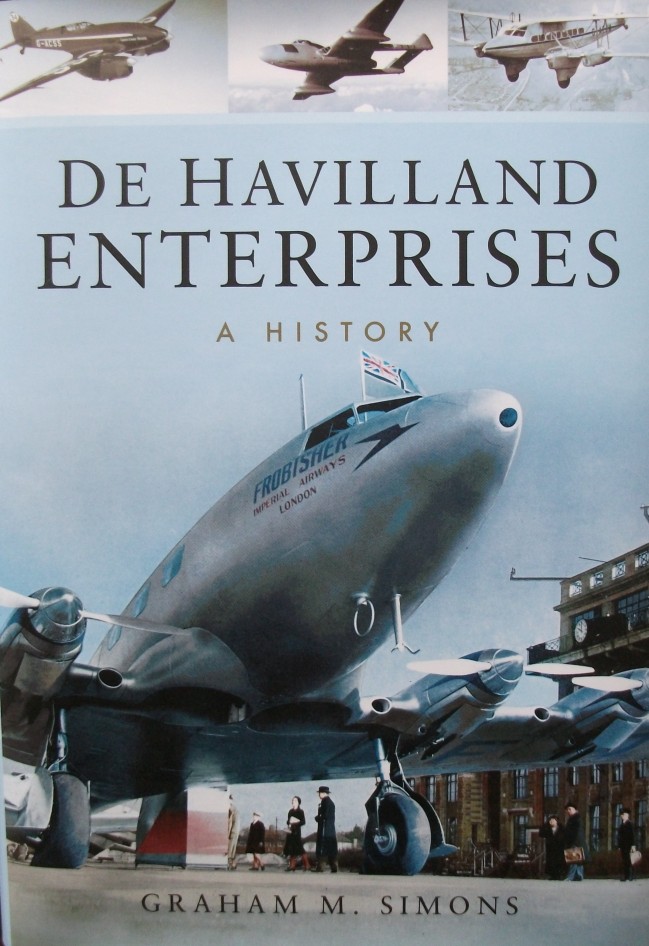
Reviewer: Michael Keith
Title: De Havilland Enterprises: A History
Author: Graham M. Simons
Total No. of Printed Pages: 318
Rating Scale (1: Very Poor, 10: Excellent): 7
__________________________________
For many years the De Havilland Aircraft Co. Ltd, of Hatfield, England was a builder of aeroplanes of quality and in quantity. . As the author summarises ‘… There was a time when every small biplane was a ‘Moth’, an entire air force trained on a ‘Tiger’ and a new Elizabethan age dawned with the introduction of the world’s first jet airliner’. This volume is a record of those aeroplanes, of the company itself, and of the design projects that were never constructed.
This volume’s primary focus is on De Havilland’s aeroplanes. All De Havilland aircraft from the Company’s No. 1 to its final DH.130 design are described. These descriptions include both those actually constructed, and those created as ‘design concepts’. Experimental types and the products of De Havilland’s Australian and Canadian factories are also included. To provide background to the aircraft, a Chapter titled The Men… records the Company’s history. This section serves as a ‘catch-all’ for anything that is not ‘aeroplane’. Within it a small section is devoted to De Havilland aero engines, but only in the context of the general narrative.
Due to the large number of designs involved, the Contents section is three pages long. Within each page four columns appear. These are titled: Type No.; Name; Quantity built* and Page No. Curiously, the headings only appear on the first page of the Contents section. Within the columns where no name was allocated to a specific type a – has been placed adjacent to the appropriate design number. In addition, where a design was an ‘idea’ only, and not proceeded with, the phrase design concept only appears in the Quantity built column alongside the appropriate design number, The * placed beside the Quantity built column-header is duplicated at the bottom of the third Contents page rather than a the bottom of each page as might be expected. It marks a paragraph which cautions that ‘Total built should be considered very much an estimate only as ‘records that date back over one hundred years are not totally reliable…’. The Contents section is in turn followed by a Dedication. Although this dedicates the volume to all those involved in the aircraft preservation movement, particular reference is made to one John Stride. An Introduction then summarises the volume. It is followed by the previously-noted chapter titled The Men…As already stated, this provides a short history of the Company. The main portion of the volume is concerned with the aircraft that De Havilland’s built. Titled The Machines…, it describes the various aircraft that De Havilland’s either produced or envisioned. A separate section is dedicated to each individual aircraft type. Within it, the specific type is both described and accompanied by a three-view line drawing. Type-specific technical data accompanies the line drawing. Where applicable, the description is accompanied by at least one monochrome photograph. Although these are largely sourced from De Havilland archives, several are from other sources. Where variations to the basic airframe are detailed, subheadings are used to describe these. There are however no drawings for either the Company’s experimental aircraft or for the products of de Havilland’s Australian and Canadian factories. There is also no Bibliography per se’, as according to the author `…This title is unusual in that is based entirely on contemporary material from De Havilland…’. There is instead a chapter tiled And Finally… This is placed after The Machines… and contains reproductions of various De Havilland-related brochures and images. Curiously, it also contains a somewhat-vitriolic attack on those who have, in the past, criticised the author over the materials he has used and his sources. An Acknowledgments section completes the book. In it the author thanks those who have assisted him in its creation. Although several half-tone images and technical diagrams appear within the volume, the Contents pages contain no reference to either these or the photographs the book contains. There are no maps or an Index.
This volume is both well researched and well-written, with the author’s passion for his subject being very evident. While there are some ‘imperfections’ the majority of these are minor. However, for this reviewer, the lack of an Index severely reduces the book’s usefulness. De Havilland’s exported many different types of aeroplanes to many countries around the world An Index would have provided the information as to what, where, why and to whom. Its lack reduces a reader to time-consuming, frustrating (and at times fruitless) searching through innumerable pages, with no guarantee of success when doing so. Were that that was not the case!
Due to the high regard accorded to the products of the De Havilland Aircraft Co. Ltd. this book is likely to have wide appeal amongst aviation enthusiasts of many persuasions in many countries. Aero-modellers will also be likely to make use of the drawings and the images for their own purposes.
As already noted, this volume has several ‘imperfections’; the lack of an Index being the most important of these. As a result, on a Rating Scale where 1: Very Poor, 10: Excellent, I have given it a 7.
—————————————————–
